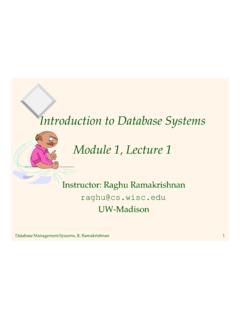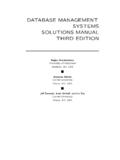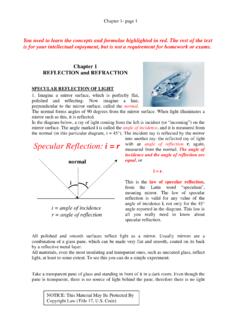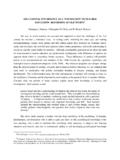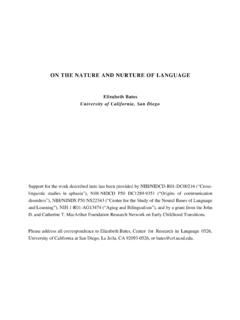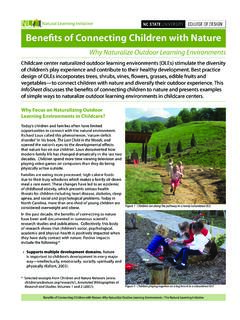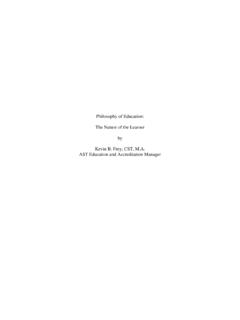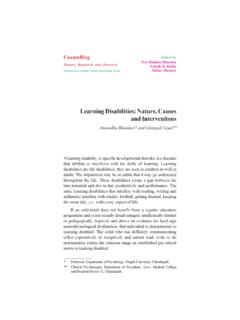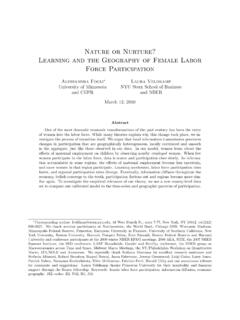Transcription of REVIEW - University of Wisconsin–Madison
1 1 Facebook AI Research, 770 Broadway, New York, New York 10003 USA. 2 New York University , 715 Broadway, New York, New York 10003, USA. 3 Department of Computer Science and Operations Research Universit de Montr al, Pavillon Andr -Aisenstadt, PO Box 6128 Centre-Ville STN Montr al, Quebec H3C 3J7, Canada. 4 Google, 1600 Amphitheatre Parkway, Mountain View, California 94043, USA. 5 Department of Computer Science, University of Toronto, 6 King s College Road, Toronto, Ontario M5S 3G4, technology powers many aspects of modern society: from web searches to content filtering on social net-works to recommendations on e-commerce websites, and it is increasingly present in consumer products such as cameras and smartphones. Machine- learning systems are used to identify objects in images, transcribe speech into text, match news items, posts or products with users interests, and select relevant results of search.
2 Increasingly, these applications make use of a class of techniques called deep learning . Conventional machine- learning techniques were limited in their ability to process natural data in their raw form. For decades, con-structing a pattern-recognition or machine- learning system required careful engineering and considerable domain expertise to design a fea-ture extractor that transformed the raw data (such as the pixel values of an image) into a suitable internal representation or feature vector from which the learning subsystem, often a classifier, could detect or classify patterns in the input. Representation learning is a set of methods that allows a machine to be fed with raw data and to automatically discover the representations needed for detection or classification. Deep- learning methods are representation- learning methods with multiple levels of representa-tion, obtained by composing simple but non-linear modules that each transform the representation at one level (starting with the raw input) into a representation at a higher, slightly more abstract level.
3 With the composition of enough such transformations, very complex functions can be learned. For classification tasks, higher layers of representation amplify aspects of the input that are important for discrimination and suppress irrelevant variations. An image, for example, comes in the form of an array of pixel values, and the learned features in the first layer of representation typically represent the presence or absence of edges at particular orientations and locations in the image. The second layer typically detects motifs by spotting particular arrangements of edges, regardless of small variations in the edge positions. The third layer may assemble motifs into larger combinations that correspond to parts of familiar objects, and subsequent layers would detect objects as combinations of these parts.
4 The key aspect of deep learning is that these layers of features are not designed by human engineers: they are learned from data using a general-purpose learning procedure. Deep learning is making major advances in solving problems that have resisted the best attempts of the artificial intelligence commu-nity for many years. It has turned out to be very good at discovering intricate structures in high-dimensional data and is therefore applica-ble to many domains of science, business and government. In addition to beating records in image recognition1 4 and speech recognition5 7, it has beaten other machine- learning techniques at predicting the activ-ity of potential drug molecules8, analysing particle accelerator data9,10, reconstructing brain circuits11, and predicting the effects of mutations in non-coding DNA on gene expression and disease12,13.
5 Perhaps more surprisingly, deep learning has produced extremely promising results for various tasks in natural language understanding14, particularly topic classification, sentiment analysis, question answering15 and lan-guage translation16,17. We think that deep learning will have many more successes in the near future because it requires very little engineering by hand, so it can easily take advantage of increases in the amount of available com-putation and data. New learning algorithms and architectures that are currently being developed for deep neural networks will only acceler-ate this progress. Supervised learning The most common form of machine learning , deep or not, is super-vised learning . Imagine that we want to build a system that can classify images as containing, say, a house, a car, a person or a pet.
6 We first collect a large data set of images of houses, cars, people and pets, each labelled with its category. During training, the machine is shown an image and produces an output in the form of a vector of scores, one for each category. We want the desired category to have the highest score of all categories, but this is unlikely to happen before training. We compute an objective function that measures the error (or dis-tance) between the output scores and the desired pattern of scores. The machine then modifies its internal adjustable parameters to reduce this error. These adjustable parameters, often called weights, are real numbers that can be seen as knobs that define the input output func-tion of the machine. In a typical deep- learning system, there may be hundreds of millions of these adjustable weights, and hundreds of millions of labelled examples with which to train the machine.
7 To properly adjust the weight vector, the learning algorithm com-putes a gradient vector that, for each weight, indicates by what amount the error would increase or decrease if the weight were increased by a tiny amount. The weight vector is then adjusted in the opposite direc-tion to the gradient vector. The objective function, averaged over all the training examples, can Deep learning allows computational models that are composed of multiple processing layers to learn representations of data with multiple levels of abstraction. These methods have dramatically improved the state-of-the-art in speech rec-ognition, visual object recognition, object detection and many other domains such as drug discovery and genomics. Deep learning discovers intricate structure in large data sets by using the backpropagation algorithm to indicate how a machine should change its internal parameters that are used to compute the representation in each layer from the representation in the previous layer.
8 Deep convolutional nets have brought about breakthroughs in processing images, video, speech and audio, whereas recurrent nets have shone light on sequential data such as text and speech. Deep learningYann LeCun1,2, Yoshua Bengio3 & Geoffrey Hinton4,5436 | nature | VOL 521 | 28 MAY 2015 2015 Macmillan Publishers Limited. All rights reservedbe seen as a kind of hilly landscape in the high-dimensional space of weight values. The negative gradient vector indicates the direction of steepest descent in this landscape, taking it closer to a minimum, where the output error is low on average. In practice, most practitioners use a procedure called stochastic gradient descent (SGD). This consists of showing the input vector for a few examples, computing the outputs and the errors, computing the average gradient for those examples, and adjusting the weights accordingly.
9 The process is repeated for many small sets of examples from the training set until the average of the objective function stops decreasing. It is called stochastic because each small set of examples gives a noisy estimate of the average gradient over all examples. This simple procedure usually finds a good set of weights surprisingly quickly when compared with far more elaborate optimization tech-niques18. After training, the performance of the system is measured on a different set of examples called a test set. This serves to test the generalization ability of the machine its ability to produce sensible answers on new inputs that it has never seen during training. Many of the current practical applications of machine learning use linear classifiers on top of hand-engineered features.
10 A two-class linear classifier computes a weighted sum of the feature vector components. If the weighted sum is above a threshold, the input is classified as belonging to a particular category. Since the 1960s we have known that linear classifiers can only carve their input space into very simple regions, namely half-spaces sepa-rated by a hyperplane19. But problems such as image and speech recog-nition require the input output function to be insensitive to irrelevant variations of the input, such as variations in position, orientation or illumination of an object, or variations in the pitch or accent of speech, while being very sensitive to particular minute variations (for example, the difference between a white wolf and a breed of wolf-like white dog called a Samoyed). At the pixel level, images of two Samoyeds in different poses and in different environments may be very different from each other, whereas two images of a Samoyed and a wolf in the same position and on similar backgrounds may be very similar to each other.




